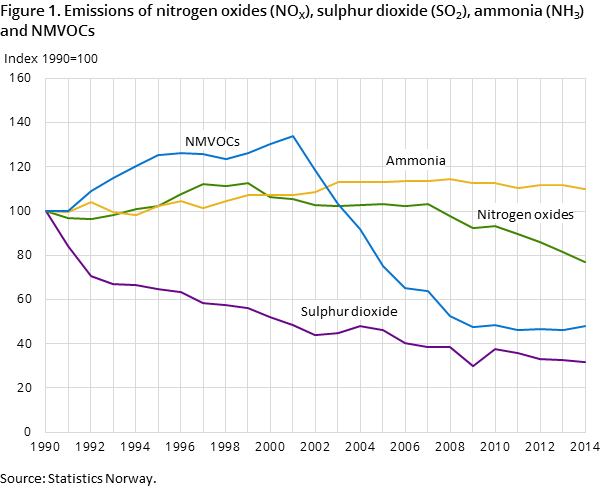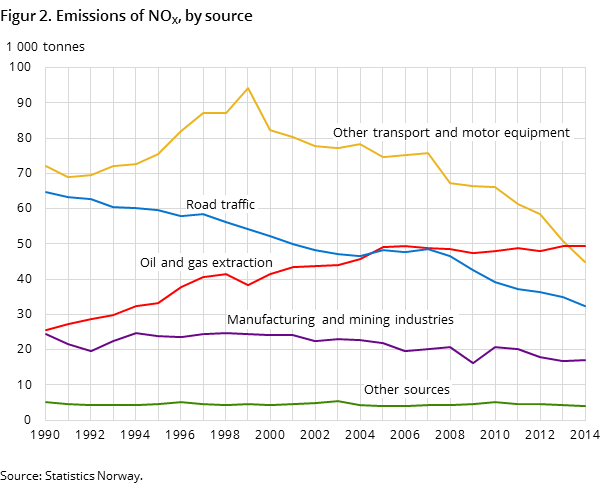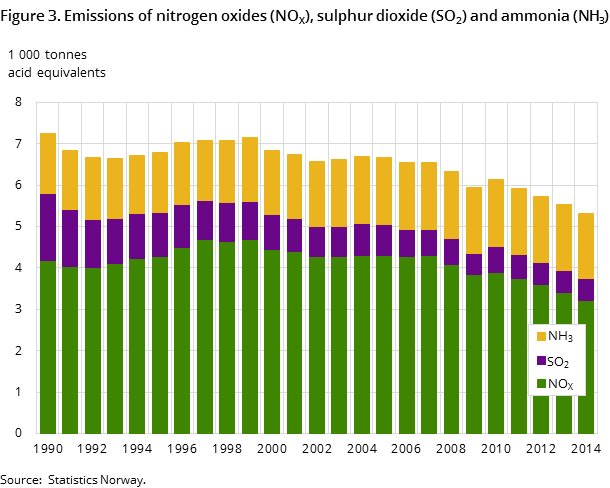Content
Published:
This is an archived release.
Norway well below emission target for nitrogen oxides
Following on from Norway meeting its international obligations for emissions of nitrogen oxides (NOX) in 2013, the decline in these emissions continued in 2014. The emissions fell by 5.4 per cent in 2014, and were around 8 000 tonnes below the target of 156 000 tonnes.
| 2014 | Change in per cent | ||
|---|---|---|---|
| Since 1990 | 2013 - 2014 | ||
| 1Does not include international sea and air traffic. | |||
| Nitrogen oxides (NOX) | 148 | -23.0 | -5.4 |
| Sulphur dioxide (SO2) | 17 | -68.1 | -2.4 |
| Ammonia (NH3) | 27 | 10.0 | -1.7 |
| Non-methane volatile organic compounds (NMVOC) | 140 | -52.0 | 3.7 |
| Carbon monoxide (CO) | 247 | -66.9 | -5.6 |



The preliminary estimations of emissions from Norwegian territory show that this decline mostly stems from lower emissions from coastal traffic and fishery. The emissions generated by diesel in offshore related activities went down by 1 800 tonnes. Despite an increase in sales of diesel, the emissions from diesel used in vehicles went down from 2013. This is due to better and cleaner combustion in new diesel motors.
A small decline in sulphur emissions
The long-term trend in the decline in sulphur dioxide (SO2) emissions continued in 2014, with a fall of around 2.4 per cent from 2013. Under the Gothenburg protocol, Norway’s maximum emission is 22 000 tonnes of sulphur dioxide, which was easily met in 2013 with an emission of 16 700 tonnes. This decline is a result of lower emissions from wood processing, coastal traffic and fishery. An increase in emissions of sulphur dioxide from metal production curbed the decline somewhat.
Less ammonia emissions from agriculture
The total ammonia (NH3) emissions went down by 1.7 per cent from the previous year, and were about 26 800 tonnes in 2014. This is 16 per cent above the emission target Norway is committed to. Agriculture contributes to 92 per cent of the national emissions of ammonia, and fewer dairy cattle were the main reason for the decline.
Warm weather contributed to lower emissions of CO
Total emissions of carbon monoxide (CO) were 6 per cent lower in 2014 than in 2013. 2014 was a warmer year than 2013, and the need for heating was therefore reduced. Emissions from household heating makes up a large share of the CO emissions, and with a decline of 10 per cent from 2013 contributed strongly to the reduction. A substantial decline in emissions from diesel-powered cars also contributed to the lower emissions.
Increased emissions of NMVOC gases
Increased emissions of NMVOC gases from the offshore industry strongly contributed to a growth in Norway’s emissions of almost 4 per cent compared to 2013. However, the emissions of 140 000 tonnes are still 28 per cent lower than the maximum of 195 000 tonnes that Norway has committed to.
Preliminary figures
The preliminary figures will be revised in December 2015. The revised figures will contain more detailed classifications of source and industry.
Norway is committed to further reductionOpen and readClose
The Gothenburg Protocol (2005, revised 2012) and the NEC directive established ceilings for the emissions of sulphur dioxide (SO2), nitrogen oxides (NOX), ammonia (NH3) and volatile organic compounds except methane (NMVOC).
The definition of which emissions are to be regarded as Norwegian differs somewhat in the Gothenburg Protocol from Statistics Norway’s emission statistics. The NOX emissions are about 1 per cent lower when using the Gothenburg Protocol definition, while smaller differences are found for the other gases.
Adjustments to the emission inventoryOpen and readClose
A revision of the emission factors for diesel engines, on off-road machinery, has caused a drop in emissions for almost all years for NOx, NMVOC, CO and NH3. Emissions of NH3 have increased.
The statistics is published with Emissions to air.
Contact
-
Statistics Norway's Information Centre
E-mail: informasjon@ssb.no
tel.: (+47) 21 09 46 42
